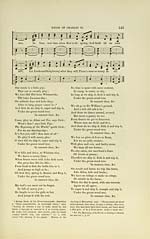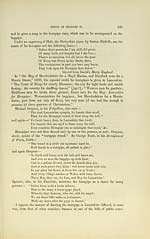Glen Collection of printed music > Printed text > Popular music of the olden time > Volume 2
(168) Page 544 - Old Lancashire hornpipe
Download files
Complete book:
Individual page:
Thumbnail gallery: Grid view | List view

544 ENGLISH SONG AND BALLAD MUSIC.
An answer to the preceding Somersetshire ballad will be found in the Douce
Collection, and to be sung to the same tune. It is " Hey for our town, but a fig
for a Zommersetshire ; " and commences —
" In winter time, when flow'rs do fade, Let lords and ladies play at cards,
And birds forsake the tree, There's none so merry as we," &c.
The burden is " Under the holly-bush tree."
THE OLD LANCASHIRE HORNPIPE.
" Thero is a Lancashire Hornpipe in my throat ; hark ! how it tickles, with doodle, doodle, doodle."
Ford's The Witch of Edmonton.
At page 12 of an edition of The Dancing Master, the exact reference to which
I have mislaid (perhaps in one of the volumes of Walsh's Compleat Country
Dancing Master) , this tune is entitled The Old Lancashire Hornpipe. In Apollo's
Banquet, 1669, 1690, and 1693, it is called A Jigg, and has twelve divisions or
variations. There were hornpipes of various descriptions ; some being called
jig-hornpipes, or hornpipe-jigs, others bagpipe-hornpipes. One of the former
will be found in the first edition of Apollo's Banquet ; and several of the latter
in " An extraordinary Collection of pleasant and merry humours ; containing
Hornpipes, Jiggs, North-Country Frisks, Morrises, Bagpipe-Hornpipes, and
Rounds,"" &c. The hornpipe-jig in Apollo's Banquet (although not so barred)
is in 2 time. About 1697, Thomas Marsden published a " Collection of original
Lancashire Hornpipes ; " but I have not been able to find a copy in any library,
public or private.
In Vanbrugh's comedy of JEsop, act v., the trumpets were to sound a melan-
choly air till iEsop appeared, and then the violins and hautboys to " strike up a
Lancashire Hornpipe."
The instrument called the hornpipe, from which the dance derived its name,
was in use in England as late as the reign of Charles II., and perhaps later.
It is, in all probability, the same as the pib-corn (which means horn-pipe) said to
bo still in use in Wales. The pipe of the latter is of hollow wood, with holes for
the fingers at regulated distances, and with horn at each end ; a small piece for
the mouth, and a larger for the escape of the sound.
Chaucer mentions the hornpipe as a Cornish instrument, —
"Controve he would, and foule faile, In Floites made he discordaunce,
With Hornpipes of Cornwaile. And in his musike with misehaunce," &c.
Romannt of the JRose.
In the sixteenth and seventeenth centuries, the counties most famous for the
dance of the hornpipe were Derbyshire, Nottinghamshire, and Lancashire. Ben
Jonson, in his Love's Welcome at Welbech, says, —
" Your firk-hum jerk-hum to a dance, To wonder at the hornpipes here
Shall fetch the fiddles out of France, Of Nottingham and Derbyshire ; "
■ There were three publications under this title, which printed by John Young, at the Dolphin and Crown, at the
I have not had the opportunity to compare. The first, West end of St. Raul's Church, without date. A copy of
mentioned by Bagford as having been printed by Daniel the last is in the possession of Mr. George Daniel, of
Wright in 1710 (small oblong of 35 pages) ; the second in Canonbury.
the British Museum, a. 10. 5, dated 1720; and the third
An answer to the preceding Somersetshire ballad will be found in the Douce
Collection, and to be sung to the same tune. It is " Hey for our town, but a fig
for a Zommersetshire ; " and commences —
" In winter time, when flow'rs do fade, Let lords and ladies play at cards,
And birds forsake the tree, There's none so merry as we," &c.
The burden is " Under the holly-bush tree."
THE OLD LANCASHIRE HORNPIPE.
" Thero is a Lancashire Hornpipe in my throat ; hark ! how it tickles, with doodle, doodle, doodle."
Ford's The Witch of Edmonton.
At page 12 of an edition of The Dancing Master, the exact reference to which
I have mislaid (perhaps in one of the volumes of Walsh's Compleat Country
Dancing Master) , this tune is entitled The Old Lancashire Hornpipe. In Apollo's
Banquet, 1669, 1690, and 1693, it is called A Jigg, and has twelve divisions or
variations. There were hornpipes of various descriptions ; some being called
jig-hornpipes, or hornpipe-jigs, others bagpipe-hornpipes. One of the former
will be found in the first edition of Apollo's Banquet ; and several of the latter
in " An extraordinary Collection of pleasant and merry humours ; containing
Hornpipes, Jiggs, North-Country Frisks, Morrises, Bagpipe-Hornpipes, and
Rounds,"" &c. The hornpipe-jig in Apollo's Banquet (although not so barred)
is in 2 time. About 1697, Thomas Marsden published a " Collection of original
Lancashire Hornpipes ; " but I have not been able to find a copy in any library,
public or private.
In Vanbrugh's comedy of JEsop, act v., the trumpets were to sound a melan-
choly air till iEsop appeared, and then the violins and hautboys to " strike up a
Lancashire Hornpipe."
The instrument called the hornpipe, from which the dance derived its name,
was in use in England as late as the reign of Charles II., and perhaps later.
It is, in all probability, the same as the pib-corn (which means horn-pipe) said to
bo still in use in Wales. The pipe of the latter is of hollow wood, with holes for
the fingers at regulated distances, and with horn at each end ; a small piece for
the mouth, and a larger for the escape of the sound.
Chaucer mentions the hornpipe as a Cornish instrument, —
"Controve he would, and foule faile, In Floites made he discordaunce,
With Hornpipes of Cornwaile. And in his musike with misehaunce," &c.
Romannt of the JRose.
In the sixteenth and seventeenth centuries, the counties most famous for the
dance of the hornpipe were Derbyshire, Nottinghamshire, and Lancashire. Ben
Jonson, in his Love's Welcome at Welbech, says, —
" Your firk-hum jerk-hum to a dance, To wonder at the hornpipes here
Shall fetch the fiddles out of France, Of Nottingham and Derbyshire ; "
■ There were three publications under this title, which printed by John Young, at the Dolphin and Crown, at the
I have not had the opportunity to compare. The first, West end of St. Raul's Church, without date. A copy of
mentioned by Bagford as having been printed by Daniel the last is in the possession of Mr. George Daniel, of
Wright in 1710 (small oblong of 35 pages) ; the second in Canonbury.
the British Museum, a. 10. 5, dated 1720; and the third
Set display mode to: Large image | Transcription
Images and transcriptions on this page, including medium image downloads, may be used under the Creative Commons Attribution 4.0 International Licence unless otherwise stated. ![]()
| Special collections of printed music > Glen Collection of printed music > Printed text > Popular music of the olden time > Volume 2 > (168) Page 544 - Old Lancashire hornpipe |
|---|
| Permanent URL | https://digital.nls.uk/91364010 |
|---|
| Shelfmark | Glen.254a |
|---|---|
| Additional NLS resources: | |
| Attribution and copyright: |
|
| Description | Scottish songs and music of the 18th and early 19th centuries, including music for the Highland bagpipe. These are selected items from the collection of John Glen (1833 to 1904). Also includes a few manuscripts, some treatises, and other books on the subject. |
|---|
| Description | The Glen Collection and the Inglis Collection represent mainly 18th and 19th century Scottish music, including Scottish songs. The collections of Berlioz and Verdi collected by bibliographer Cecil Hopkinson contain contemporary and later editions of the works of the two composers Berlioz and Verdi. |
|---|

